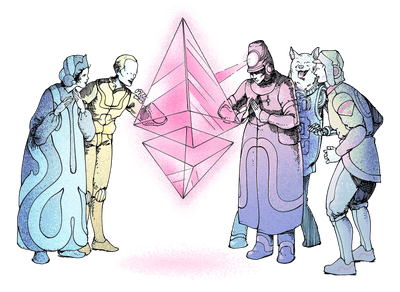Ethereum Gets An Upgrade 🚀
Dear Investors,
The Ethereum community's highly anticipated Shanghai hard fork, also known as "Shapella," has finally been implemented, granting users who have "staked" their ether (ETH) the ability to withdraw their funds. This hard fork, which involves upgrading the blockchain by creating a new one, is considered a significant milestone in Ethereum's multi-year shift towards a complete proof-of-stake network.
Proof-of-stake systems require users to stake their cryptocurrency as a security measure to confirm and secure new data blocks. Ethereum abandoned its original proof-of-work consensus mechanism last year, leaving Bitcoin as the only popular proof-of-work digital currency. This controversial move was done for both environmental reasons and to increase transaction through-put.
Source: Ethereum.org
Common Uses of Ethereum
Ethereum is the second mainstream cryptocurrency after Bitcoin and was built for developers to build and deploy decentralized applications (DApps) using smart contracts. These smart contracts are self-executing computer programs that automatically execute the terms of a contract when certain conditions are met. (Think if this, then that).
The most common uses of Ethereum today are:
Decentralized Finance (DeFi) platforms for lending, borrowing, and trading without intermediaries.
Non-Fungible Tokens (NFTs) for unique digital assets like digital art, gaming items, and other collectibles.
Supply Chain Management applications for tracking and verifying product authenticity and ownership, which increases transparency and reduces the risk of fraud.
Decentralized gaming ecosystems that enable players to earn cryptocurrency rewards for in-game achievements.
It is important to note that during the recent DeFi and NFT bubbles, the network became overrun and congested, leading to unreasonably high transaction fees.
The Shanghai Update
To secure the Ethereum network and participate in the block validation process, validators must stake at least 32 ETH, locking their funds in a smart contract. The more ETH a validator stakes, the higher their chances of proposing a block of data transactions to be confirmed on the blockchain, earning them additional rewards when approved by other validators.
Not everyone can afford to stake a full 32 ETH, leading to the emergence of liquid staking providers. These providers allow users to contribute any amount of ETH, which is then staked and run by third-party providers on behalf of a collective of clients. Currently, the largest liquid staking provider, Lido, controls approximately 23% of all staked ETH. Additionally, some of the world's largest crypto exchanges, such as Coinbase, Kraken, and Binance, control another 22% of staked ETH.
With the recent upgrade triggered, users can now make partial withdrawals and claim their rewards immediately, a vital feature of the new system that was previously unavailable.
Buterin, the founder of Ethereum, recently noted that scaling, or improving transaction speed and cost, will be the next challenge that the blockchain will address after the Shanghai hard fork. He emphasized that failing to address scaling before the next bull run could result in users being stuck paying exorbitant transaction fees of up to $500.
In a November 2020 blog post, Buterin expressed concern that proof-of-stake (PoS) could lead to higher wealth concentration over time. This is because PoS requires only ether to stake, and participants can earn more ether by staking. In contrast, proof-of-work (PoW) still rewards participants with ether but necessitates external resources. Buterin argued that over time, PoS coin distributions risk becoming more concentrated.
Ethereum had an overall green week, surpassing $2100, with many predicting that another crypto "alt-season" will follow the current price action.
Myth Of Money - the Book 📚
As some of you already know, I’ve been working on turning The Myth of Money into a book about how money actually works. As economics taught in schools becomes more outdated and what we find on the internet increasingly more confusing, it’s important to create reading material that is accessible, engaging, and story-driven. This is the ethos behind the newsletter and the book.
I’m starting conversations with publishers and book agents. If you have someone in your network you think I should speak to, please respond to this email. Thank you! 🙏
This Week By the Numbers 📈
US inflation took a bigger plunge than anticipated in March, dropping to 5%, but there's still this nagging feeling that getting prices completely under control will be harder than predicted, especially since the core CPI figure held its ground. The drop from February's 6% was predictable, as the oil price hikes in the aftermath of Russia's invasion of Ukraine are now baked into the comparisons. Core CPI, however, remained nearly unchanged at 5.6%. Transportation witnessed the steepest price surge, at 13.9%, followed by food prices up by 8.5% and shelter by 8.2%. Energy prices, however, took a 6.4% dip.
Meanwhile, Blackrock’s Larry Fink has stated that the Fed will likely raise rates two or three more times, to a total of 75 bps. He said inflation was "coming down" but questioned whether it could be brought below the 4% level.
Top Stories 🗞️
Elon Musk founds new AI company called X.AI
Elon Musk has created a new company dedicated to artificial intelligence — and it’s called X.AI, as first reported by The Wall Street Journal. The company, which a Nevada filing indicates was incorporated last month, currently has Musk as its director and Jared Birchall, the director of Musk’s family office, listed as its secretary. Rumors about Musk starting up an AI company have been floating around for days, with a report from Business Insider revealing that Musk had purchased thousands of graphic processing units (GPUs) to power an upcoming generative AI product. The Financial Times similarly reported that Musk planned to create an AI firm to compete with the Microsoft-backed OpenAI. Musk even reportedly sought funding from SpaceX and Tesla investors to get the company started.
Twitter partners with eToro to show real-time stock and crypto information
Twitter has partnered with the investment platform eToro to show real-time information about stocks and crypto prices. This expands upon the social network’s Cashtag feature, which provided info about a limited number of stocks and crypto coins through TradingView data.The social media company first introduced the feature in December, letting users search for a ticker or coin symbol like $TSLA, $APPL or $ETH to get prices directly in search results. In a tweet announcing the feature, eToro said that users will be able to see the real-time prices for a “much wider range of stocks, crypto, and other assets.”
FTX has recovered $7.3B in assets, will consider rebooting exchange
Cryptocurrency exchange FTX may be considering restarting in the future, according to the legal team behind the debtors. In an April 12 hearing in the United States Bankruptcy Court for the District of Delaware, lawyers with Sullivan & Cromwell representing FTX said the crypto firm had recovered roughly $7.3 billion in liquid assets. A March filing from the debtors reported the four FTX company silos had roughly $4.8 billion in scheduled assets as of November 2022, with an investigation into the assets ongoing. According to the legal team, FTX will also consider restarting its crypto exchange operations sometime in the second quarter of 2024 — suggesting a reboot as early as April. FTX CEO John Ray was reportedly mulling reviving the bankrupt exchange in a January interview.
Solana’s Crypto-Ready ‘Saga’ Smartphone Goes on Sale May 8
Solana Labs’ crypto-forward smartphone Saga will go on public sale May 8, the company behind the Solana blockchain said Thursday. Pre-ordered devices are shipping now. The Android smartphone is a gamble on mobile being imperative to the future of crypto, employees at Solana-focused companies told CoinDesk. It was nearly 10 months ago that Solana first teased the radical potential of a cellphone that doubled as a dedicated crypto hardware wallet, and the possibilities such a product could hold for its entire ecosystem. The new device from Solana Mobile costs $1,000 and is built on hardware from Bay Area smartphone company OSOM. It has 512 GB of storage, two versatile back camera lenses, a 6.67-inch OLED display and a fingerprint scanner. It will ship with the latest Android operating system installed.
Amazon announces 'Bedrock' AI platform to take on OpenAI
Amazon announced on Thursday it's releasing an AI platform for businesses called Amazon Bedrock, which will compete with enterprise offerings from OpenAI and others in the generative AI space. Bedrock is a suite of generative AI tools that can help Amazon Web Service customers — businesses who run their operations on Amazon's data servers — build chatbots, generate and summarize text, and make and classify images based on prompts. Bedrock users can perform specific tasks by selecting from a range of machine learning models it calls "foundation models," such as AI21's Jurassic-2, Anthropic's Claude, Stability AI's Stable Diffusion, and Amazon Titan. A content marketing manager, for example, can use Bedrock to create a targeted ad campaign for a new line of handbags by feeding it data so it can generate product social media posts, display ads, and web copy for each product, according to an AWS blog post.
Upcoming Speaking Engagement 🤓
I’m excited to share a fireside chat this Friday with the Malibu community, co-hosted by the Blockchain at Pepperdine program and Graziadio Business School.
This free event is open to the public as well as students. CLICK HERE to register.
Thank you for reading this week’s edition of the Myth of Money.🚀
Until next week,
Tatiana Koffman
About the Author: Tatiana Koffman
Hi there and thanks for reading! If you stumble upon my newsletter, you will notice that I write about money, economics, and technology. I hold a JD/MBA and spent my career in Capital Markets working across Mergers & Acquisitions, Derivatives, Venture Capital, and Cryptocurrencies. I write to make financial topics more accessible and create equal opportunity for the next generation of investors. I have personally invested in 20+ companies and funds (👉 my portfolio).




